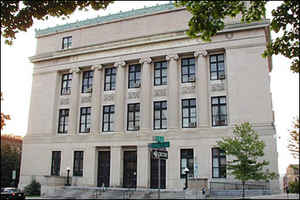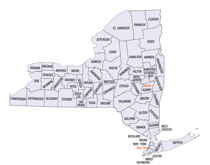New York Counties
There are sixty-two counties in the State of New York. The first twelve counties in New York were created immediately after the British annexation of the Dutch colony of New Amsterdam, although two of these counties have since been abolished. The most recent county formation in New York was in 1912, when Bronx County was created from the portions of New York City that had been annexed from Westchester County.Albany County, New York
Albany County Education, Geography, and History
Albany County is a county located in the state of New York; its northern border is formed by the Mohawk River, at its confluence
with the Hudson River, which is on the east. Based on the 2010 census, the population was 304,204. The county seat is Albany, the state
capital. As originally established by the English government in the colonial era, Albany County had an indefinite amount of land, but has
only 530 square miles (1,400 km2) as of March 3, 1888. The county is named for the Duke of York and of Albany, who became James II of
England (James VII of Scotland).
Albany County constitutes the central core of the Capital District of New York State, which comprises the Albany-Schenectady-Troy, NY
Metropolitan Statistical Area.
Etymology - Origin of Albany County Name
Named in honor of the Duke of York and Albany, who later became James II of England
Demographics:
County QuickFacts: CensusBureau Quick Facts
Albany County History
Albany was one of the twelve original counties of colonial New York as established by Governor Thomas Dongan in
1683.
By definition, Albany County was to "containe the Towns of Albany, the Collony Renslaerwyck, Schonecteda, and all
the villages, neighborhoods, and Christian Plantacons on the east side of Hudson River from Roelof Jansen's Creeke,
and on the west side from Sawyer's Creeke to the Sarraghtoga." In time, its boundary lines would become more closely
defined!
But practicaly speaking, until the late 1760s, most people thought of Albany County as the entire upriver region of
the province. Any more precise definition of its boundaries was the subject of much controversy involving Yankees
and Yorkers, the French, and Native peoples. However, its expansive nature is depicted on a number of contemporary
maps.
Albany County was composed of a number of political sub-divisions. Located on a map of the province dated 1776, they
included the City of Albany, the Manor of Rensselaerswyck (later broken into Watervliet, Bethlehem, the hilltowns,
and the East Manor), the town or borough of Schenectady, the village of Kinderhook, Schaghticoke, Livingston Manor,
Saratoga, Hoosick, Great Imboght, Catskill and Coxsackie, Schoharie, Claverack, King's District, German Camp, and
Cambridge.
For most of the colonial period, the city and county of Albany sent two and then three delegates to the Provincial
Assembly. Rensselaerswyck and later Schenectady (beginning in 1726) also were allowed one delegate each. From its
earliest days, the Albany County militia was composed of residents of the county's community and was organized by
locale.
In 1774, Albany County was the most populated county in colonial New York with 42,706 settlers. In 1790, the count
had reached 75,921 inhabitants and it still was the most populated county in what now was New York State. By 1800,
Albany County had achieved its present boundaries as Rensselaer, Saratoga, Schenectady, Schoharie, Greene, and
Columbia Counties had been split off from it. Albany County was now confined to the west side of the Hudson River
and south of the Mohawk. Consequently, its population had dipped to 25,155 people!
Henry Hudson's 1609 voyage northward ended near Albany, where the river that bears his name became impassible for his ship. His Dutch sponsors built Fort Nassau on Westerlo Island in 1614, serving as an administrative outpost for the fur trading ventures of the Dutch West India Company in Manhattan.
Geography: Land and Water
Albany County is in the east central part of New York State, extending southward and westward from the point
where the Mohawk River joins the Hudson. Its eastern boundary is the Hudson River; a portion of its northern
boundary is the Mohawk River.
As reported by the Census Bureau, the county has a total area of 533 square miles (1,381 km2), of which, 523
square miles (1,356 km2) of it is land and 10 square miles (25 km2) of it (1.83%) is water.
The terrain of the county ranges from flat near the Hudson and Mohawk Rivers to high and hilly to the southwest,
where the Catskills begin. The highest point is one of several summits near Henry Hill at approximately 2,160 feet
(658 m) above sea level; the lowest point is slightly above sea level along the Hudson.
Neighboring Counties
Bordering counties are as follows:
- Schenectady County, New York - north
- Saratoga County, New York - northeast
- Rensselaer County, New York - east
- Columbia County, New York - southeast
- Greene County, New York - south
- Schoharie County, New York - west
Education
Albany College of Pharmacy
Albany Law School
Albany Medical College
Bryant & Stratton College
Excelsior College
The College of Saint Rose
Sage College of Albany
Sage Graduate School
Siena College
State University of New York at Albany







